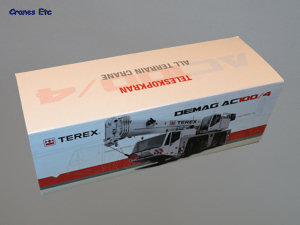 | | Terex style box. |  | 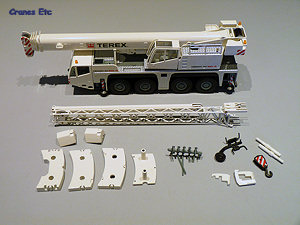 | | The various model parts. | 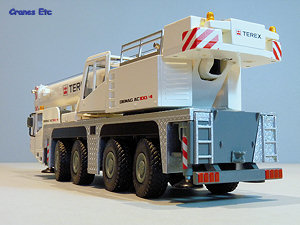 | | Rear view with counterweight removed allowing an unusual view inside the end of the boom. | 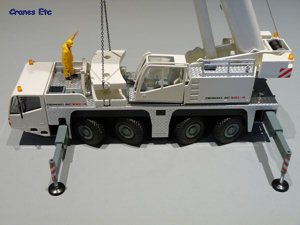 | | Loading up the counterweight. |  | | Lifting a column. | 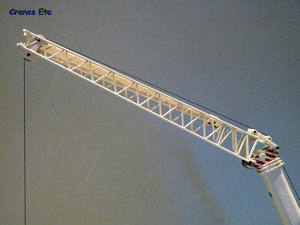 | | Fly jib attached at an angle. Swing away extension not used. | 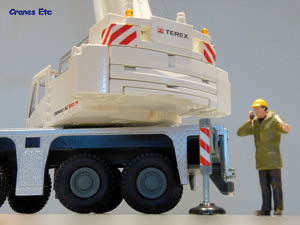 | | Cheek weights fitted. |
| The Terex Demag 100/4 is nominally a 100 tonne capacity mobile crane. The main boom can be up to 50m long and a fly jib can add up to another 27m of length. It can be rigged with a maximum of 26 tonnes of counterweight.
Packaging
The model comes in standard two piece expanded polystyrene trays held together by a picture sleeve which has a photo of the real machine, but no other information about it. The review model had no defects or missing parts.
There are no instructions provided with the model but assembly is straightforward for anyone but a complete beginner, and takes little time. An instruction leaflet would have been a good addition nonetheless.
Detail
The carrier is typical of Conrad. Robustly made and with a reasonable level of detail, although not as much as now provided by some other makers. Underneath there is little detail to speak of on the chassis. The wheels have good all terrain tyres mounted on standard plastic Conrad hubs which would have been improved with some black paint on the centres to more closely resemble the real machine. The outrigger beams are made of tough plastic and the pistons are standard screw threads which is a method gradually being taken over by more realistic looking pistons on other models.
The driving cab has wing mirrors which the collector has to attach, and there are good orange beacon lights on the roof. The headlights have nice plastic lenses and there is a loop for tying up the hook during transport. Interior detail is fairly basic. Behind the cab, the carrier deck detail is good, with diamond plated surfaces and a nice exhaust system.
The crane cab has plastic grab rails and inside there is a simple rendition of the operator's seat and controls. The rest of the body is cast well, with some metal hand rails and the counterweight slabs are detailed with lifting points which could be used to attach chains, except for those on the cheek weights.
The boom sections are metal and they model the simple lines of the real crane well. There is a spooling drum on the lowest section but this would have been better modelled in black to mimic the crane in the photo on the box. In the boom head the pulleys are plastic, but separate, so they are free rolling. The fly jib has a convincing metal lattice work section and the swingaway part is plastic although the colour match is excellent so it is hard to tell.
A single pulley hook is provided, and this has nice red and white stripes.
Features
The steering works very well and consists of linked front and rear pairs of axles. This means crab steering can be simulated, but not all the steering modes of the real crane as axles 3 and 4 are not independent.
The outrigger beams are two stage and can be pulled out to any extension and the pads lowered. They can successfully hold the weight of the crane.
The crane cab tilts smoothly to a good angle.
A good feature is the counterweight which can be attached to simulate different configurations, including some pieces being loaded on the carrier deck to even the load on the wheels during transport. This is not fully implemented though, as although some weights can be carried above the front two axles, none of the slabs are cast to enable them to be carried properly on the rear of the carrier.
All the usual crane functions work fine with the crane rotating and the boom able to be set at a reasonable angle, and the boom cylinder is stiff enough to hold a pose. The five section telescopic boom can be smoothly extended to full length and each section has the usual locking mechanism to prevent the boom retracting.
The fly jib is pinned to the boom head using small plastic bolts and can be fixed to be straight, or at one of two offset angles. The swingaway portion can be pinned into position or left retracted so overall the fly jib provides a variety of display options.
The winch is operated by turning the winch drum directly and it has enough friction to hold a reasonable load.
Quality
The model is typically well made and strong. The paintwork and graphics are sharp and look good
Price
This crane is fair value for a four axle crane.
Overall
Terex Demag have commissioned a solid crane model from Conrad and it is up to their usual standards of model engineering and manufacture. It can be posed in a variety of ways which makes it a good display model. The detail level is not as high as found on some comparative models from Chinese makers, but it is good enough to represent the real crane satisfactorily. It is an easy model to recommend.
Footnotes
The model first appeared at the end of 2008. A version in Grohman colours (silver) appeared at the Nuremberg Toy Fair in 2009 and went on sale later in the year. Versions appeared in Schmidbauer and Kavanagh colours in 2010.
|
| |
| 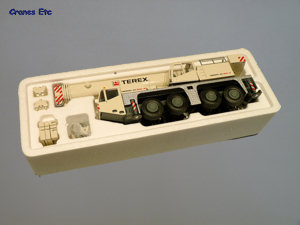 | | The model inside the box. | 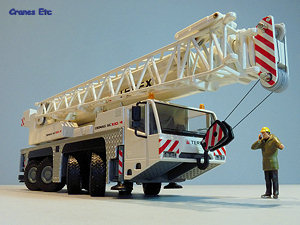 | | Front view. Steering angle is very good. | 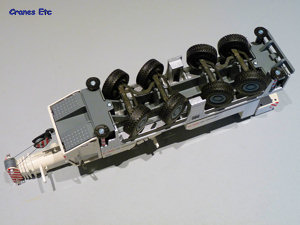 | | Underside view. | 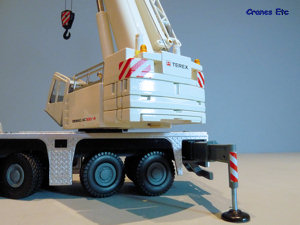 | | Counterweight attached, except for the cheek weights. Cab tilted. | 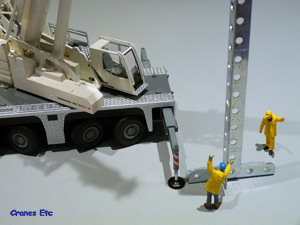 | | Two stage outrigger beams. | 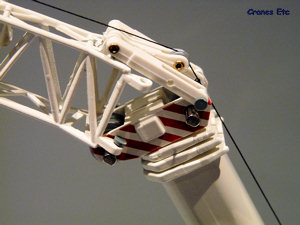 | | Attachment at the boom head. | 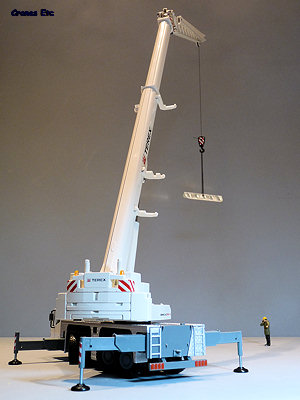 | | Lifting a beam. |
|

